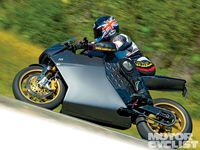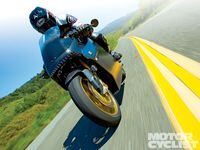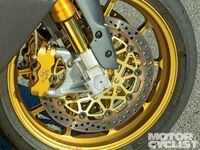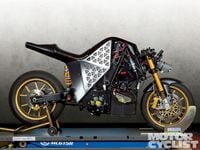For the thrill-seeking sportbike rider accustomed to savage acceleration and the shrieking howl of a tuned exhaust system, riding a silent and sedate electric bike is far from enthralling. That's where the Mission One superbike produced by San Francisco-based Mission Motors comes in. Mission's, ahem, mission is to change the way people feel and think about electric bikes.
The Mission One sportbike, which I first saw last year at Bonneville as it streaked across the salt flats at 150 mph on its way to an electric motorcycle land-speed record, is scheduled to hit the marketplace in May of 2011. I've been told that the performance I witnessed at Bonneville has been injected into the production bike, which will be introduced as a premier, limited-edition package for the hefty price of $68,995. Will this new e-superbike break the mold and do for electric motorcycles what the Tesla sports car did for the Prius et al? I headed to Misson Motors HQ to find out.
My day-long test ride on the pre-production Mission One began with a trip north over the Golden Gate bridge. A short jaunt on the 101 freeway provided the opportunity to confirm the bike's triple-digit speed potential, after which we peeled off the highway and made our way to the Pacific Coast Highway. After hooking up the bike for a 90-minute recharge while I did the same with a plate of seafood, we headed back to the city the long way 'round, enjoying the area's fantastic back roads and fittingly riding as far south as Silicon Valley before reversing course and returning to San Francisco. "We" were myself and Mission Motor's software engineer Seth LaForge aboard his Ducati 916-many of the MM missionaries are active riders.
So, what did that day of riding in the California sunshine prove? Only that the Mission One is a contradiction in terms completely unlike anything I've ridden before. It's a zero-emissions sportbike that's fun to ride and will outperform an R1, RSV4 or 1198 off the mark, albeit without the agility and nimble handling of its lighter gas-powered brethren. It's got everything you want from a sportbike, including a good sound. Unlike other e-bikes, where the "sound of silence" detracts from the riding experience, the Mission One utters a muted but decidedly angry rasp when you get on it, a combination of native motor noise, primary gear whine and chain buzz.
You need to tiptoe to climb aboard the tall single seat, where you'll be forced into a decidedly sporty riding position. To boot up the bike, flip the switch hidden behind the lower right fairing flank and press the red E-STOP button mounted to the top triple clamp, then flick on the ignition switch to the right of the four mounted at the back of the dash. The others are there to activate the pumps and fans for the motor and ECU cooling systems.
Launch procedure complete, you're ready to roll. Twisting the ride-by-wire throttle (what else would there be on an electric bike?) too hard will set the rear Michelin spinning, so practice restraint as this thing warrants respect. The Mission One's meaty maximum torque of 115 lb.-ft. is available as soon as you get the engine turning, making this the easiest bike yet to wheelie, even without a clutch to help you coax the front end up. And with little engine noise, you can stunt your way along city streets where any loud-piped streetbike would quickly attract the local constabularies. Not the Mission One: Ladies pushing strollers stood watching in amusement as I popped silent wheelies along Dogpatch driveways on this most civilized of hooligan bikes. Yet riding the Mission One slowly in traffic is almost too easy. There's no clutch lever, so you don't have to cramp up your left hand, just work the throttle gently on and off. But at such speeds there's no foretaste of what's on offer once you have space to motor.
Because out in the real world of no-compromises sportbiking, there is literally nothing with sparkplugs and a license plate that will out-accelerate the Mission One off the mark._ Nothing_. This literally awesome and definitely addictive launch performance comes in spite of the bike's hefty weight of 525 pounds. Although the e-superbike feels a tad cumbersome at slower speeds, the bike's dynamics work well at a quicker clip.
The digital speedo is easy to read, ditto the dash panel next to it telling you the single most vital fact you need to know: your remaining range. There's also a secondary readout showing the remaining charge in the separate 12-volt batteries that drive the oil and water pumps, fans, lights and dashboard display. This small secondary pack is supposed to be kept charged via a link from the main batteries, and it was that link that packed up 130 miles into our ride. We still had 30 miles left on the main batteries after that 90-minute recharge at lunch, so I'd go along with MM's claim of a 70- to 90-mile range for the bike in spirited use. Two hours would have been needed to fully recharge the batteries.
People get too excited about how much horsepower their bikes put out, swapping numbers like stock-market traders as if that's all that matters. Only it isn't. What is vastly more relevant in real-world riding is maximum torque and the shape of its delivery curve. Torque equals acceleration, and that's the forte of any e-bike, especially this one. The Mission's claimed 136 horsepower is quite impressive for a supersport, except that this bike weighs 50 percent more than your average 600. Yet the awesome blast of drive available from the moment you open the throttle comes courtesy of that huge helping of torque. This e-superbike's torque completely eclipses everything else on the street, especially any scooter, which the twist-'n'-go, direct-drive Mission One most closely resembles dynamically.
To start with, though, we had a problem. It came from the regenerative braking used to recapture some of the kinetic energy expended while stopping the bike-a system that is said to extend range by up to 14 percent. Mission Motors had the regen set too high, introducing what was in effect a severe dose of engine braking every time I backed off the throttle. Laforge supplied a solution over lunch, pulling a laptop out of his backpack to reprogram the regen so it was less intrusive. That may also have lessened the amount by which it recharged the batteries, but now the Mission was ready to carve corners, gliding through turns on part throttle with a total lack of vibration before picking up the drive on the way out. Now it more closely resembled a conventional gas-powered bike, but with no need to notch down a couple of gears to get the engine singing up high in the super powerband. Just twist and fly!
There's no shying away from it: The creation of the Mission One is a key step in the evolution of the sportbike, in redefining the way we think about how we can go fast and have fun on two wheels in the uncertain future. "What sold me on coming to work here was not zero emissions, but a recognition that the world has changed very much in the past 10 years," says MM CEO Jit Bhattacharya. "We can no longer take energy sources for granted-especially fossil fuels. So why are we even having this conversation about electric motorcycles? The principle behind the Mission One sportbike is actually similar to a company like Tesla's. For so long we have associated electric drive with sacrifice, with having to give something up by switching to electricity, so you get a heavier, slower, lesser-performing vehicle whose primary value to the customer is that it's 'green.' The public needs to have its perceptions about electric drive changed, and the best way to do this is to build something electric that blows their minds, that performs in a way they didn't think was possible, and that they can buy. That's the Mission One, and in building it we want to demonstrate that no compromises need to be made to bring about a change, and start a revolution."
Mission Accomplished.
2011 Mission One
Hard Parts
Battery
The flat-sided architecture of the next-generation lithium-ion batteries in the Mission One permits much denser packaging than the more common-place cylindrical cell, which is an important space-saving issue in a minimalist vehicle like a motorcycle. Produced by EIG in South Korea, the LI cells use a chemically stable and physically durable solid polymer electrolyte and flexible foil casing. Highway cruising will yield approximately 100 miles of range, while aggressive sport riding will drain the battery in about 70 miles. A full charge takes 2.5 hours when plugged into a 220-volt/30-amp socket or 8-10 hours in a standard 110-volt wall socket.
Electronics
Transmitting the batteries' charge to the motor dictates the use of an ECU, termed the "controller." Channelling upwards of 100kW of power requires robust electronics and generates enough heat to warrant a dedicated liquid-cooling system. The MM-developed controller is the soul of the motorcycle and is responsible for power delivery and throttle response, which can be tailored to a degree that MotoGP teams only dream of. The bike's software interface allows riders to adjust throttle maps, tweak regenerative braking, set power limits and pre-set multiple riding modes.
Motor
Game-changing power comes from an electric motor the size of a soccer ball. The Mission One's 350-volt AC brushless motor produces a respectable 136 horsepower and abundant torque: some 115 lb.-ft. from 1-6500 rpm. That's 10 lb.-ft. more than Harley's ground-rippling V-Rod Muscle! The motor gets hot enough to warrant its own oil-cooling system. The only moving parts in the motor that could potentially fail are the bearings supporting the rotor.
Chassis
Battery and motor packaging directed much of the Mission One's frame architecture. The trellis frame is constructed from chromoly tubing and was designed with input from James Parker, the U.S. chassis guru best known for the hub-center RADD front end on the Yamaha GTS1000. An aluminum box-section swingarm supports the rear tire and pivots on the primary gear housing, while trail can be altered between 90 and 105mm via the Attack Performance adjustable triple clamps.
Suspension/Brakes
As the debut limited-edition model, the Mission One will be laden with top-shelf components. Both front and rear forged-magnesium Marchesini wheels will be controlled by Öhlins dampers-a race-ready, TiN-coated 43mm fork up front and a TTX36 shock out back. The pre-production bike we rode was outfitted with ISR brake parts, but when the bike goes on sale early next year it will be equipped with Brembo components. The regenerative braking system is incorporated into the rear wheel to convert kinetic energy to electrical power while providing reassuring engine braking.
Evolution
A blank-slate creation from a hive of San Francisco-based engineers, visionaries and entrepreneurs.
Rivals
Mavizen TTX02, Roehr eSuperbike and the yet-to-be released Brammo Empulse and MotoCzysz e1pc.
Contact
Mission Motor Company
2255 3rd. St.
San Francisco, CA 94107
www.ridemission.com
Verdict: 3.5 stars out of 5
Thrilling and exhilarating, as any superbike should be, electric or otherwise




















/cloudfront-us-east-1.images.arcpublishing.com/octane/VZZXJQ6U3FESFPZCBVXKFSUG4A.jpg)
/cloudfront-us-east-1.images.arcpublishing.com/octane/QCZEPHQAMRHZPLHTDJBIJVWL3M.jpg)
/cloudfront-us-east-1.images.arcpublishing.com/octane/HXOUJXQWA5HBHGRO3EMJIGFMVI.jpg)

/cloudfront-us-east-1.images.arcpublishing.com/octane/3TIWWRV4JBBOLDVGRYECVVTA7Y.jpg)
/cloudfront-us-east-1.images.arcpublishing.com/octane/KIX5O23D5NAIBGFXBN3327DKZU.jpg)
/cloudfront-us-east-1.images.arcpublishing.com/octane/7GJYDUIPXRGMTMQKN6ONYOLBOU.jpg)
/cloudfront-us-east-1.images.arcpublishing.com/octane/MUQLOVLL2ZDGFH25ILABNBXKTI.jpg)
/cloudfront-us-east-1.images.arcpublishing.com/octane/TNOU5DNE2BC57MFPMGN2EIDXAM.jpg)
/cloudfront-us-east-1.images.arcpublishing.com/octane/GTCXACQGJ5HAPDTGWUQKDEH44E.jpg)
/cloudfront-us-east-1.images.arcpublishing.com/octane/S35YGSEMEZB4BLTDJTSZPF4GLA.jpg)
/cloudfront-us-east-1.images.arcpublishing.com/octane/5UOT6HPX2JFMRJAX6EH45AR4MQ.jpg)
/cloudfront-us-east-1.images.arcpublishing.com/octane/OKWOJWAKP5EP3OACCRRWPCIX2Q.jpg)
/cloudfront-us-east-1.images.arcpublishing.com/octane/2WF3SCE3NFBQXLDNJM7KMXA45E.jpg)
/cloudfront-us-east-1.images.arcpublishing.com/octane/G4MG6OUCJNBSHIS2MVVOTPX65E.jpg)
/cloudfront-us-east-1.images.arcpublishing.com/octane/IIGGWFOTOJGB7DB6DGBXCCMTDY.jpg)
/cloudfront-us-east-1.images.arcpublishing.com/octane/QSTCM6AVEZA5JJBUXNIQ3DSOF4.jpg)
/cloudfront-us-east-1.images.arcpublishing.com/octane/U4I7G625B5DMLF2DVIJDFZVV6M.jpg)
/cloudfront-us-east-1.images.arcpublishing.com/octane/B6XD6LS6IVCQPIU6HXDJSM3FHY.jpg)
/cloudfront-us-east-1.images.arcpublishing.com/octane/ICL63FEDDRDTTMINYICCEYGMDA.jpg)
/cloudfront-us-east-1.images.arcpublishing.com/octane/FCGZHQXRBZFLBAPC5SDIQLVF4I.jpg)
/cloudfront-us-east-1.images.arcpublishing.com/octane/WNOB6LDOIFFHJKPSVIWDYUGOPM.jpg)

/cloudfront-us-east-1.images.arcpublishing.com/octane/X33NU3E525ECRHXLNUJN2FTRKI.jpg)